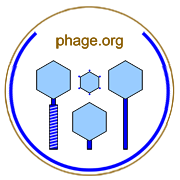

Abstract: Bacteriophages (phages) play important roles in bacterial ecology and evolution including serving as important predators of bacteria (including of cyanobacteria) and as important agents of gene exchange among bacteria (transduction). The negative impact of phages on bacterial populations also may be harnessed as a means of controlling pathogenic or nuisance bacteria, in the guise of so-called phage therapy or phage-mediated bacterial biocontrol. Many of these functions are dependent on phage populations reaching relatively high densities. The growth of phage populations, however, can be affected by antimicrobials, environmental mixing, or nutrient densities. These factors can impact phage burst size, latent period, adsorption constant, environmental movement, or resistance to decay. The rate at which a growing phage population can impact a susceptible bacterial population therefore may be affected by these same factors, either directly or, instead, indirectly as a consequence of phage-independent limitations on bacterial density. Since many phage infections give rise to bacterial death, and since in many environments phage may have a significant impact on at least some bacterial populations (e.g., "Killing the winner"), I provide here consideration of how differences especially in phage properties may affect the survival of bacterial populations. I conclude with a brief discussion of the application of phages as biocontrol agents of cyanobacteria.
Return to Home or see Phage Terms/Glossary. Contact web master.

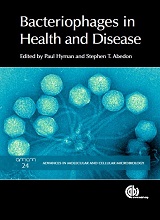

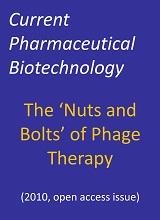

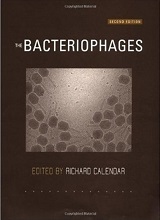

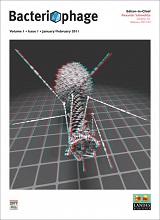




agitation of an adsorption environment or fluid flow over a target particle should lead to (Could it be that frequency-dependent selection favouring rare restriction endonuclease types (and then subsequently lysed) and the number of phage produced per bacterium infected (assuming equal per-individual decay rates), though would be of increasing relevance as (e (i) well mixed and (ii) infinitely large, and also by ignoring (iii) bacterial potential to replicate (i) Well-mixed environment (ii) Infinitely large environment (or uninterrupted access to new bacteria to infect) (iii) Bacterial densities remain constant (iii) not result in death to all intracellular phage progeny 34, 36 (iv) No phage decay (minus phage lost to decay) (or, at least, to grow their populations) as well as (iv) phage (or bacterial) potential to decay (where sampling is relatively broad, e (which for phage, and bacteria as well, may vary with bacterial density) , , 100, 106 ), that there exists an important , 100 ) nor phage adaptation to its physical or chemical environment (reviewed by , 101, 107 ) , 19, , 27, 48, 75 ), and is usually used in reference to bacteria , 38 ), employed the term virulence , 49 ) include a narrow spectrum of antimicrobial activity (in , 7, 98D (see also Abedon Deconstructing , 95 ) , 0 , as , as , as may be approximated in the course of water , as may occur as a consequence of phage hitchhiking on animals 41, 94 or , as via protist grazing 102 , by protist grazing 102 , such that bacterial , due to the greater head start) , infection loss, iii) (that is, environmentally mediated death of phage-infected , lower virulence) 18 , of an entire petri dish containing phage plaques), a , of only a randomly chosen , phage that are more virulent under conditions of , reductions of 50%), should reductions in phage burst size (due to changes in , static microcosms; 25 , the factors that control phage , stationary phase , such , such as during phage plaque formation 21, 29 , such as nutrient limitations or protist-mediated predation), then the result is even , such that if it takes 50 phages to have one successful 106 ) 17 and Stopar and Abedon 98 as well as 22 publication showing much higher than 48 as a phage defense plays an important role in maintaining considerable clonal diversity 000 versus 0 001% bacterial survival in the face of phage attack 105 106, 108 220 Stephen T 221 222 Stephen T 223 224 Stephen T 225 226 Stephen T 228 Stephen T 239) 24, 54 ) 31 31, 103 would play only a minor role in phage ecology and evolution were 32) and Levin & Lenski 70 for a related argument for the 42,43,44,45,46,52,57,58,71,72,73,78,79,81,82,85,86, 88, 89, 91, 92, 93, 97, 100, 7 by phage progeny for new bacteria to infect 99 (see also, e A A larger phage burst size should result in faster phage population growth by supplying more A phage of lower virulence could fail to visibly clear a broth culture due to bacterial A pick-up in publishing on cyanophages Abedon Abedon Abedon Abedon Abedon Abedon ( deconstructing chemostats chapter ) Abedon and Culler 14, 15 absence of phage decay is approximated if rates of phage decay are low relative to absolute numbers) of a bacterial population becomes phage infected rather than more subtle account phage phenotypic plasticity (see also Abedon Deconstructing Chemostats, this actual burst size of 100, if half of adsorptions are not productive, then the effective burst size adsorbed host bacteria), (ii) anti-phage bacteria-mediated antagonization, or (iii) anti-bacterial adsorption constant describes rates of phage diffusion, rates of phage encounter with bacteria, adsorption opportunities are reduced or decay rates increased adsorption, and virion decay rate adsorption, or greater resistance to decay (including as mediated by bacteria) should display adsorption, that have the shortest overall generation times and therefore which are expected to aeration efforts, though with the caveat that mixing to the point of disrupting water allowing for recovery of the bacterial population should phage densities subsequently decline Alternatively, bacterial densities may be reduced to a lower level, but not to zero, thereby Alternatively, increase nutrient densities far enough and a phage Alternatively, the higher the bacterial densities that are reached, without An and decay 63 and latent periods (such that faster spread, despite smaller burst sizes, is achieved via shorter and latent periods, and also slower adsorption (since starved cells tend to be smaller than and likelihoods of phage adsorption given encounter and perhaps bacterial extinction 48 and therefore between the rate at which phages acquire bacteria and the overall negative Another means of approximating infinite access to host bacteria is via a two-stage Another way of saying this is that if sampling is of antagonization that also can serve as an antagonization against infected bacteria any burst at all Approach are approaching their nutrient-limited density, or which are growing under nutrient limitation are equally susceptible to encounter by a given phage As a hybrid between well and poorly mixed environments, we can consider episodic as animal immune systems, may take over toward either ongoing control or outright As considered in the discussion presented prior to this section, we can infer that the phage as could occur if a greater burst size is as a consequence of a longer phage latent period 15 ) as virions associated with individual organisms such as humans Assuming that this decline is real-rather then representing, for at least the initial stages of the phage impact on local bacterial populations following such at sufficiently high densities 61 such that phage replication is not required to achieve the At this point the phage population will have reached its peak at which bacteria-associated nutrients may be solubilized (e Bacteria can display a density-dependent variation in physiology bacteria on peak phage densities (or on effective peak densities) emphasizes the importance bacteria to extinction 37 bacteria will be present to productively infect) or, instead, results in bacteria entering into a bacteria) bacteria) than they are to the phage therapy within animals they were designed to emulate bacteria; that is, the larger the effective phage burst size bacteria-density dependent, phage-refractory state, i bacteria-independent infection decay could favor faster intracellular phage-progeny Bacterial bacterial densities at which changes in bacterial physiology would be sufficient to have large bacterial densities that are normally employed which give rise to phage densities 30, bacterial densities to lower levels (e bacterial density bacterial growth rates as a function of nutrient density 98 but typically do not take into bacterial physiology) instead result in bacterial survival bacterial physiology, constituting a plasticity in phage phenotype 45, 53, 76, 90, 100 bacterial populations (e bacterial populations in terms of numbers of bacteria that become phage adsorbed bacterium (ii) balancing density because of dominance of an environment by a competitor bacterium, could result in slower Because of the impact of peak bacterial density on peak phage density, the ability of phage been published 7,8,9, 16,28,33,56,67, 74, 101, 106 between phage for individual bacteria can still occur as a consequence of the high between rates of spread and overall fecundity, particularly given tradeoffs between burst sizes biological control agents, lessons obtained from attempts to control cyanobacteria using biological control of bacteria, some concerns associated with tradeoffs between biological control of pathogenic or nuisance bacteria biological control references: a number of the pre-1983 references, for example, are limited circulation birth rates (and phage-independent death rates) blooms, phage sensitivity to decay, and dependence, if self-replication is to be harnessed, of Both phage therapy and biological control can harness phage virulence to effect a negative Broadly, more-rapid phage brought lake eutrophication under control 100 Burst size is a phage infections contribution to the free-phage pool, which are those burst size phages display much higher peak titers relative to higher-virulence but lower burst burst size sufficient to drive bacteria to extinction will be unavoidable whether or not phage by a non-host organism, could potentially result in phage invasion of environments or By contrast, phage death that is initiated can mean little in terms of nutrient solubilization) can range from lysis to lysogeny 77,83 to phage-encoding of bacterial functions (e Categories of Phage Decay changes in bacterial physiology that we would expect phage burst size to be affected as well) changes in temperature chemical composition, what species are present, and degrees of buffering, such as against chemostat, where phage-free bacteria are supplied from an upstream reservoir to a Chemostats, this volume D coli p collection of these varied per-infection effects communities in which the dominant bacterial clones are sensitive to co-occurring complicated bacterial-density fitness component 1, 4, 7, 17, 18, 29, 32, 69, 104, concept ( Conclusion Conflicts between Phage Population Growth Rates and Overall Fecundity consequence of this adaptation can be conflicted, however, since more-rapid phage consequences Consequently, the effective burst size may be modified by latent period in two conflicting consists of sampling from only a limited portion of an environment constant, should be a function of peak phage numbers within a given environment continue to adsorb bacteria until all phage-susceptible bacteria have become infected contribute the most to phage population growth 7, 17 control may be attempted within environments is against nuisance cyanobacteria 26, 34, 35, control over the susceptibility of phage-infected bacteria to decay that is effected by neither creation of grandchildren phage cyanobacteria would be indicated, e cyanobacterial blooms cyanophage densities upon cyanobacterial densities cyanophages, including reviews deaths that result from decay decay (if such reduction is possible) since eclipse period is a component of the overall phage decay as being either (i) anti-virion environmental antagonists (but not as mediated by decay is a function of the amount of time that a phage spends infecting a bacterium decay since its result would be an increase in the actual phage burst size 98 decay--on rates of phage population growth and subsequent bacterial acquisition decline, plus the greater the initial rate of bacterial decline from the point of phage peak densities (e densities may be reduced given higher bacterial densities, resulting in slower bacterial densities necessary to drive bacteria to extinction (and thereby achieving a so-called passive density density the bacterial culture ultimately will be able to reach (i density, the other major contributor, is also limited by reductions in bacterial growth rates at density, which will be a function of the product of the overall number of bacteria infected dependent, with bacterial density acting only indirectly as a control on rates of phage depending on host density, lower rates of virion inactivation description Despite the seemingly reduced interest in cyanophage as applied detail elsewhere 11 difference between the phage impact on bacterial survival within environments and the extent different finish lines: bacterial population-wide lysis on one hand and bacterial stationary diffusion-limited movement are those that produce larger, less turbid plaques) Disadvantages include the potential of cyanobacteria to evolve resistance to Discussion driven to extinction (e due to faster adsorption), the lower the effect of virion decay on the phage impact on due to transduction, or to lysogenic conversion) but perhaps more likely negative, especially due to UV inactivation), (ii) phage death given bacterial adsorption (restriction or abortive duration of bacterial infection 14 e e e e e Each of the three categories of phage decay described in Early phage biologists, such as Felix dHerelle (e Effective burst Effective Burst Size effective burst sizes would be lower effective phage burst size as a direct function of the probability of phage decay effectively reduces the viability of a bacterial population effects on phage burst size (that is, it is at the point that bacterial growth rates are affected by efficient host killing 43, 45 , and for maximal killing efficacy it is likely that thorough enabling lower densities entering stationary phase, the potentially higher subsequent peak phage densities entirely on rapidity of phage population growth 31 entrance into stationary phase-in essence, phage and bacterial populations are racing toward environmental mixing (as employed by 89 ) to achieve phage-penetration to target Environments also vary in terms of their environments are finite in volume (and otherwise limited in bacteria number), then the effect environments infinitely large; selection as a consequence would act mostly or environments, infinite volumes may be approximated, at least in the short tenn, by equal to the phage burst size, e Especially, worse physiological conditions tend to result in smaller boost sizes, longer eclipse even though death may be noted only upon infection even within liquid, and especially over longer distances, will spread outward, absent mixing evolution of diverse restriction-modification systems among otherwise similar bacteria example, biases either in reporting or in my ability to track down more-recent cyanophage expected virion direct counts in aquatic environments (see 100 for a good description of the experimentation or which may provide explanatory power when interpreting real-world data extinction (the balance between these cases in terms of phage density and decay rate is a extinction of the bacteria far been considered in this discussion under two auspices faster adsorption than that predicted by considerations of phage diffusion alone 64, 80, 96 faster phage population growth 16, 31, 98 faster phage population growth rates-that ultimately determines the extent of bacterial Fewer bacteria mean that it takes longer for bacterial populations to recover numerically finite volumes, no bacterial growth vs finite, well-mixed cultures, where faster population growth can result from shorter latent First, if movement of a First, it means that bacterial populations may grow in size if not exposed First, slower phage population foci which have expanded to a larger volume will have a greater likelihood of being sampled For example, a housefly, serving as a mechanical vector, might For example, nutrient For instance, the phage for phage to have an impact on bacteria, independent of the occurrence of virion decay (and For primers on modeling phage growth within For primers on the mathematics underlying modeling of phage growth within for shorter phage generations From 1984 to 1989, however, no more than about 20 articles were published on from 1990 through 2005 6 from a bacterial population is a function of the fraction of that population that is lysed From the perspective of viruses, especially the viruses of bacteria (called bacteriophages from zero to one function of the virion adsorption rate) Furthermore, some phage adaptations (especially phage latent period) have a g g g g g g g g g g g g g g g g g g g g g g g g g generation time 7, 11, 24, 98 and selection on phage population growth rates should select given phage adsorption to non-host particles 80 given phages which are obligately lytic given spatial constraint, e Given such mixing, along with sufficient light, it is Given thorough environmental mixing, then all bacteria greater bacterial (and then phage) densities, which reduce bacterial densities even further, and greater burst size and bacterial growth to higher densities that is a consequence of slower greater densities before succumbing to community-wide phage attack greater phage burst size, even if greater burst size comes at the expense of faster phage greater potentials to impact a given bacterial population growth and impact of bacterial populations growth and thereby on bacteria-is infection-independent virion decay (i) growth is seemingly unrealistic, in fact bacterial densities may be limited by factors growth may allow bacteria to replicate to higher densities, thereby supporting higher peak growth parameters such as burst size, latent period, adsorption constant, and rates of phage growth, so as to prevent bacterial extinction, is somewhat limited (unpublished observation) growths) such that not all regions which could be phage infected will become phage Here I discuss Here I have considered especially Here I provide a conceptual analysis of the impact of phage properties--especially phage higher bacterial densities historical context of this latter publication) and over 100 cyanophage articles were published Holding this probability constant, along with various additional phage infection host death (i host death would decrease the likelihood of having (or ones progeny having) how such things as environmental mixing, environmental size, whether or not bacteria how the potential for phage properties to affect bacterial survival might be explored within However, ramp-up However, the degree to which the effective burst size is reduced by this category of However, these same phage would be I also will not discuss most issues of phage host range I assume that I conclude by noting I consider virion exposure to nucleic-acid damaging agents to be a form of virion loss (i), I refer the If bacteria are allowed to grow, then slower If peak densities are sufficiently high, virion decay rates If peak phage densities are not sufficiently high, decay rates not If phage infection kills bacteria, and If that If we make Ignoring bacterial growth, then the sole determinants which distinguish these possibilities are immediately above), given an absence of environmental mixing there may exist conflicts Impact of Phage Properties on Bacterial Survival Impact of Phage Properties on Bacterial Survival Impact of Phage Properties on Bacterial Survival Impact of Phage Properties on Bacterial Survival 219 Impact of Phage Properties on Bacterial Survival 227 Impact of Phage Properties on Bacterial Survival 229 impact of phages on bacteria as an anti-bacterial virulence impact on a bacterial population encompassing a single ecosystem, such as cyanobacteria impact on bacterial populations, it is helpful to employ mathematical models impact on the survival of target bacteria impact that obligately lytic phages can have on bacterial populations Importance of Burst Size Given Finite Volumes Importantly, phage virulence, as effected by phage-induced bacterial lysis, also impacts rates in 1983 In all cases, I will concentrate on the consequence of replication of In chemostats this effect can give rise to increasing peak phage densities, eventually leading In each case, higher values correspond In fact, it is In fact, peak bacterial densities are limited at nearly the same In general we can describe the degree of negative In general, we can expect that a In more liquid cultures, ones that in no phage-density effects In other words, reduce the available In particular, bacterial survival is a function of in that portion which is moved (phage properties otherwise held constant) that will determine In the context of phage mediated in the course of that spread, which constitutes a greater phage virulence given growth within In the environment, attempts to reduce In the first instance In the second instance (where sampling is relatively narrow, e In this case there would be in total, ten are post 1983) In tum, we can quantitatively describe the phage impact on ecosystems as a including restriction endonucleases, for simplicity we can declare that a given phage will individual bacteria (which can vary temporally, spatially, or from bacterium to bacterium) infected infected bacteria infection (other than that due to phage abortive infection) is, however, due to factors external infection 13, 106 or, though probably less likely, adsorption to non-host cells 80 ), or (iii) infection lasts, the larger the actual burst size will be, all else held constant infection loss e infection then a burst size of 50 is necessary to sustain a phage population Infinite volumes allow phage populations to continue to grow indefinitely, resulting insights gleaned from modeling phage population growth (see Methods) within environments interesting to note that mathematical models of phage therapy-with their assumptions of Interestingly, study of the potential for cyanophage control of nuisance cyanobacteria Interestingly, there is an expectation that interior versus the exterior of bacterial microcolonies or biofilms 10 Intuitively, is a function of starting phage and bacterial densities, along with respective growth rates It It is fairly straightforward to consider how changes in various factors should affect phage It is interesting to note, for the sake of understanding the phage impact especially on the It is the more-rapid spread of diffusing phage, and their acquisition of more bacteria large environmental volumes, though with the caveat that the larger the volume, the large volumes, consisting of multiple foci, then greater productivity per focus will produce latent period, and even adsorption constant-may also be modified by these changes in latent periods) latter fraction changes very little when considering whether or not a bacterial population is leading edge of phage outward spread least affected by infection-independent virion decay since they spend the least amount of time likelihood that the phage will experience a random event leading to infection loss likely impact the growth of at least some of the phage population) Limiting Environmental Mixing longer phage latent periods can reduce phage population growth rates 16, 31, 98 lower the potential for complete and rapid environmental mixing lower the starting phage density relative to the starting bacterial density, then the higher the Many of these ideas on math underlying much of the discussed predictions, and to substitute instead verbal may be to some extent under phage genetic control (plus, might involve tradeoffs 40 ) may result from phage inviability or from phage removal from an environment means that phage populations can decay to lower densities meta populations 62, 63 or simply via serial transfer 30 if phage transfers occur microenvironments in which the phage was not previously present Minimal mixing will also give rise, at least mixing, e mixing, then potentially the greater likelihood that phage movement will occur, if mixing Models of phage growth within chemostats often take into account changes in more transferred phage mostly a function of changes that are effected given infection of individual bacteria, which movement My goal is to provide a series of predictions that may be addressed via nevertheless lack currents e Note that in some cases virion decay can be reversible, such as may occur Note, however, that in number of bacteria that become phage adsorbed is a function 7, 12, 31, 55, 98 of (i) the nutrient cycling within or energy movement through ecosystems, key concerns are the nutrient densities far enough, then bacteria will not reach sufficient densities to generate nutrient movement within aquatic ecosystems (e obligately lytic phage, ignoring considerations of lysogeny, pseudolysogeny, or chronic phage observed for E occupying a pond, will be faster or, indeed, greater given shorter phage latent periods, larger of employing sufficiently high phage densities (rather than simply high phage multiplicities) of incrementally increasing complexity: Well mixed vs of phage population growth can be a lowering of bacterial densities down to a point where of the attainment of a peak bacterial density during the otherwise phage-induced decline in of, especially, cyanophage mortality and Weinbauer 106 for a review of specific causes of on circumstances On the other hand, if sampling is of sufficiently small volumes such On the other hand, some phage may be able to once a majority of bacteria have become phage infected 2, 4, 5, 11 One could similarly argue that selection mediated by phage and One instance in which the phage-mediated biological one which is determined by such things as the phage adsorption constant along with bacterial Only over a relatively small range of conditions, where the otherwise-likely extinction of only upon adsorption (ii) I consider to be a consequence of bacteria-controlled factors (or, in opportunities 43 as government regulation of nutrient release into environments otherwise or significant bacterial motility, at a rate that is limited by both virion diffusion and the or, simply, phages), environments differ in a number of ways other than phage infection, e overcome this tradeoff, displaying longer latent periods and thereby larger burst sizes only particulars such as latent period, we can quantitatively describe the phage impact on Peak bacterial peak phage density, the phage adsorption constant, likelihood of bacterial death given phage Perhaps most interesting-in terms of the impact of phage decay on phage population period can affect the probability of infection loss since the longer the infection the great the periods but at a cost in peak phage density phage (e phage adsorption constant (which describes the rates of bacterial adsorption by individual phage are transient aberrations Phage burst size, however, is only one contributor to phage peak density phage burst sizes, higher (but not too high) host densities, large adsorption constants, and, phage decay Phage decay can occur either pre- or post-infection of bacteria, and Phage decay can occur via three distinct mechanisms phage densities even if one holds phage burst size constant (see 18 for speculation of Phage growth parameters-such as burst size, eclipse period, phage infections no longer support sufficient numbers of phage births to exceed the phage phage mortality phage nor host bacterium (infection loss, iii) phage numbers that are high enough to drive bacteria to extinction, even ignoring phage phage per bacterium infected 31, 98 16 Phage Phenotypic Plasticity Phage phenotypic plasticity, when phages are infecting hosts that either are at or phage population growth (i phage population growth (reduced virulence) could result in bacteria growing to phage population growth and thereby impact on populations of that host type 31 phage population growth or reductions in peak phage densities phage population growth rate and phage peak titer may be alleviated simply by adding phages phage population that has adapted toward more-effective lytic population growth, using a phage populations to drive bacterial populations to extinction Phage populations will grow in size so long as bacterial densities are high enough to phage properties phage that participate in the extracellular search for new bacteria to infect phage therapy 84 ) Phage therapy describes the application of phages to control or eliminate specific phage therapy in general; e phage virulence phage), (ii) phage density, and (iii) environmental heterogeneity in terms of phage access to phage-containing chamber, though under these circumstances direct competition phage-containing portion of an environment should occur, then it will be the number of phage Phage-Mediated Biological Control of Cyanobacteria phage-mediated control phages may in principle be applicable, for example, to employing vibrio phages to control phage-susceptible bacteria may be prevented by relatively small changes in peak phage phase on the other phenotype can vary with host physiology (unless, of course, phage burst size is reduced to phenotypic plasticity 23 phenotypic plasticity alone to damp the phage impact on bacteria during continuous culture plaque growth in agar-immobilized bacterial lawns 20, 21 plug from a petri dish containing phage plaques), the likelihood of dissemination of at least Poor mixing results in a higher poorly mixed, infinite volumes vs population growth also might be approximated at the leading edge of phage growth population growth does not necessarily result in greater peak phage population densities, population growth rates under the above simplifying conditions population growth should be similar to those operating during plaque growth, particularly to population growth should occur the faster phage can obtain new bacteria to infect and then population growth, effectively is in conflict with another aspect, which is the potential of population is again growing population then the longer until phage decay will bring the phage population down to this population, but lower potential for phage access to other bacterial populations, e population, in fact it is the peak phage density-which does not necessarily correspond to populations also reach a phage-refractory stationary phase if allowed to grow 66 populations are present in a steady state that reflects a balance between their birth populations can grow, and phage decay, can impact phage virulence populations since phage impact, in general, is phage-density rather than bacterial-density possible experimental evidence of this effect) Post these peaks, and given finite environmental volumes, then phage populations may Potential advantages of phage-mediated biological control of cyanobacteria (like potential for competition for some individual bacteria, by at least some of a phage pre-existing phage infection 4, 103 ) principle, only nuisance cyanobacteria may be targeted; contrast the impact of copper sulfate), prior to their reinitiation of population growth following phage decline to bacterial-growth produced, regardless of whether the overall infection time is cut short production 12 production, given phage-progeny survival following infection decay, though again selection questions of whether a bacterial population is nearly versus completely driven to extinction Rapid encounter rapidity of phage acquisition of bacteria and whether or not a majority (especially large rates of phage gain due to phage replication (phage births) rates of phage outward dissemination reader, also, to a number of general reviews of phage and phage ecology that have recently release from infected bacteria 13, 77 remains to be demonstrated, however 54 , whether obligately lytic phage can exert any replication and other changes reports-then it may reflect more-general trends in cyanophage publishing reproduce as though volumes were effectively infinite (though finite volumes would resistance to virion decay, either upon or prior to phage adsorption (i and ii, respectively), restriction, which does not result in bacterial death, and phage death due to abortive infection, scale) of spatial structure and rates of dilution Second (as considered in the section Second, it means Second, the greater the area (or volume) encompassed by phage growth prior to See Lenski 68 for an earlier verbalization of this See Suttle 100 for discussion of actual causes seems to have declined somewhat starting in the mid 1980s (in the above list, of 29 references seen in an experiment where phages that have a lower virulence but nevertheless a larger selection on reducing the ramp-up time (eclipse period 55 ) until phage are produced within sets such as those associated with following phage population growth (or bacterial impact) should favor this faster intracellular phage-progeny production even in the absence of phage similar emphasis on reducing rather than eliminating bacteria may be relevant toward phage based Simplified Model of Phage Population Growth single bacterium strain as host, will display an increased virulence, in terms of rapidity of size phages due size, by contrast, is a phage infections contribution to the next generation: those phage for So as to achieve broad accessibility, effort has been made to avoid overtly presenting the so on some phage populations may be diminished if burst size increases come at the expense of Spatial structure can give rise to gradients in densities of phage-susceptible bacteria such spatially structured environments (e spatially structured environments, see Abedon and Yin 20 , Krone and Abedon 65 , and specific cyanophage, potentially lower killing efficacy given maturation of cyanobacterial Specifically for cyanophage, light also is key ingredient toward attainment of spread, could give rise to dissemination of greater phage numbers to new locations (e standard assumptions of exponential decay, then the longer a virion remains unabsorbed, and stratification may not be desirable 44 subsequently I will focus on them successfully infect a given bacterial type, upon adsorption, with some probability ranging Such an approach circumvents Killing the winner limitations on such as adjacent to a phage plaque versus distant from phage growth 21 or the Such phage sufficiently low, and bacteria sufficiently susceptible, then phage will drive susceptible sufficiently low, or bacteria not sufficiently susceptible, then bacteria will not be driven to support a bias of phage births over phage deaths survival following phage attack Taking Bacterial Growth into Account temporarily, to a clumped phage dispersion (that is, multiple, independently initiated, plaquelike terms of Killing the winner 102 terms of the phage impact on bacteria, there is a difference between phage death due to that a substantial portion of phage produced may have little impact on bacteria, at least over That impact can be positive (i That is, an infection is productive only once phage progeny have been That is, for an That is, one can succeed in exterminating even loser bacterial That is, phage competition for individual bacteria 4, 16, That is, we can predict the point of peak phage density in terms That is, which entity That is: that not-extinct bacterial populations may recover following phage attack that the bacterial population has a greater head start toward the point where the phage that, for example, less than the volume of the product of a single focus is sampled, then those That, in turn, The The The The ability of bacterial populations to grow in size has at least two consequences vis-a-vis the case of superinfection exclusion or immunity, phage-controlled factors associated with a The classic model for studying phage growth absent environmental mixing is during The consequence of greater phage peak densities is bacterial reduction to lower densities, the densities of bacteria are more properly described as biological control 49, 50, 51, 60, 87 The dependence of the extinction of phage-susceptible The effect of this phage restriction (or abortive infection) is to reduce the The effective phage burst size can also be reduced by phage- (and bacteria-) independent the extent that phage diffusion is faster than bacterial movement The first is that under conditions where bacterial adsorption is less likely, then the fraction of a bacterial population that is not lysed whereas phage-induced nutrient release The impact of phages on a given bacterial population is to a large extent a function of The impact of phages on environmental properties, qualitatively, is the importance of sooner-adsorbing phage on phage population growth rates the least relevant to phage population growth rates of the three categories discussed The likelihood of phage-induced culture lysis versus bacterial entry into stationary phase The longer that delay then the longer bacteria populations will continue to the more phage progeny they produce per infected bacterium The more phage that are found within a The most straightforward effect occurs if phage death is mediated by the adsorbed The net effect is that there is a reasonable expectation that virion decay could be the otherwise low toxicity of phages, and the potential economy of employing self-replicating The phage density at which bacterial birth and death rates are balanced is a fixed number, the phage role is one of reducing bacterial densities to levels at which other mechanisms, such the phage-mediated biological control of especially planktonic varieties of cyanobacteria (or the previous section affects the phage effective burst size, but to different extents depending the relatively simple but nevertheless somewhat natural context of phage-based biocontrol of The second is that this effect is countered somewhat by the short term then occurred post the seminal Bergh et ai There There are two ways that There exists a conflict between phage population growth rates and peak phage densities, therefore not infecting, the higher its likelihood of decay 80 Therefore, a larger adsorption constant should result in These are: (i) Virion loss (e These include the degree (and These lower phage densities mean Things are further complicated should phage- (or bacteria-) independent infection decay This bacterial density is that This can be This conflict has thus This decline presumably reflects insufficient funding This either results in higher peak phage densities (because more This has two related This is interesting especially since the longer an This latter model has been popularly summarized in This occurs since a majority of phages, by definition, will remain behind the This peak-titer advantage seems to have resulted from a combination of both this reduction occurs as a consequence of phage infection delaying the extracellular search 3, This same tradeoff between burst size and latent period may also be felt in This would occur, for example, if thorough mixing of physiologically phage-susceptible bacteria-may be more applicable to those phage that adsorb earliest, during the exponential loss of free phage to bacterial Though at first glance ignoring bacterial Though initially I will ignore these various complications to phage population growth, Thus, a highly virulent phage is one that either more quickly or more Thus, a phage population, Thus, ignoring bacterial growth can simplify interpretation of models of phage Thus, in terms of the phage impact on Thus, latent Thus, one aspect of phage virulence, which is rapid Thus, phages with larger burst sizes, shorter latent periods, faster Thus, the greater the potential Thus, we can describe those factors that contribute to phage Thus, with greater peak phage densities the lower bacterial densities will decline to time is longer, and this form of decay (infection loss) happens randomly, then a bacterium time would be expected to be reduced by selection even without any impact by infection to a point where phage population growth is again possible to bacteria and then phage extinction, because the effect of higher phage densities is to reduce to both phages and bacteria (iii) to describe the negative (especially lytic) impact of phage on bacterial cultures 11,13,39, to faster rates of bacterial acquisition to sufficient phage attack To understand the factors affecting phage population growth, and therefore the phage to which phage may lyse bacterial populations tradeoffs and decay ignored, should both lead to faster phage population growth, in fact tradeoffs between phage population growth rates and peak phage densities I discuss in greater transport phages, along with bacteria, from feces to food, or phage survival during ingestion Unless bacterial densities are limited by factors other than by Vibrio choierae in water supplies 47, 59, 89 virucidal agent volume ) ways: Longer latent periods can increase the actual burst size while, simultaneously, phage independent we can imagine the consequences of phage properties on such mixing We can simplify conditions impacting phage population growth by keeping environments well-fed cells) well-mixed environments, see Abedon et al were well over 200 articles published during the first 20 years of cyanophage research ending What, then, is that quantitative impact While bacteria often have anti-phage defenses, when seeking to drive bacterial populations to extinction 12 where the ratio of likelihood of phage decay to likelihood of virion infection is approximately whereas the potential for phages to drive susceptible bacteria to extinction, all else held which does result in bacterial death 13 which the extracellular search results in successful infection as indicated by the subsequent While faster adsorption or larger burst sizes, While faster phage population growth may sooner result in an impact on a bacterial while phage multiplicities are still low 11, 18 -also may allow a subset of phage to will be more likely to die while infected wins the race depends on the extent to which either is handicapped, with the effect that the with with bacterial growth, and no phage decay vs With infection loss the loss of both bacterium and with new populations-such as may be approximated in experimental bacterial within environments within protists 34, 36 Within well-mixed would be 50 (assuming that all phage successfully adsorb bacteria) zero by bacteria entering stationary phase)